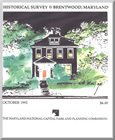Brentwood Historical Survey

Title:
Brentwood Historical Survey
Author:
The Maryland-National Capital Park and Planning Commission
Prince George's County Planning Department
Publication Date:
10/01/1992
Source of Copies:
The Maryland-National Capital Park and Planning Commission
14741 Governor Oden Bowie Drive
Upper Marlboro, MD 20772
Number of Pages:
66
This report summarizes the findings of an historical/ architectural survey of Brentwood, requested by the Mayor and Council of the Town. The goals of the project were to document the earliest of the historic buildings still standing in the Town, and to prepare a written history of the community’s development with emphasis on the early residents. The Town of Brentwood is located in Prince George’s County, just outside the northeast boundary of the District of Columbia. Development of the community began in the 1890s in areas platted by the Holladay and Brentwood Companies. The first residents were families attracted to the area by the easily accessible transportation to and from work in Washington, D. c., offered by the Baltimore and Ohio Railroad and the City and Suburban streetcar line. The residents of this community incorporated in 1922 as the Town of Brentwood. The report is divided into seven major sections: Pre-Subdivision History, The First Subdivision, The Second Subdivision, Growth and Development of the two Subdivisions, Continued Development, The Development of Community Institutions, and the Period of Incorporation. The report includes background history on the earliest development of the community, and on Captain Wallace A. Bartlett, the principal figure in the development of the first two subdivisions. It describes the expansion of the original subdivision, and the settling of the first families in the newly built homes. It describes and compares the first dwellings erected in the community; it analyzes by building type a representative group of dwellings which survive from the first building period. The report also outlines the establishment of community institutions such as school, church, citizens’ association and firemen’s organization, and describes the community’s development as it approached incorporation in 1922. The report is supplemented by photographs, plats and maps.

 Historical Survey Brentwood_Maryland_October 1992
Historical Survey Brentwood_Maryland_October 1992